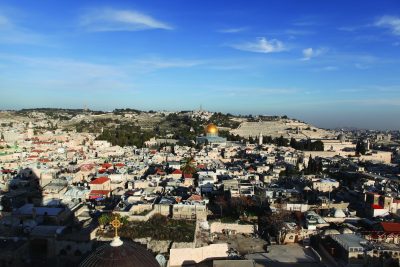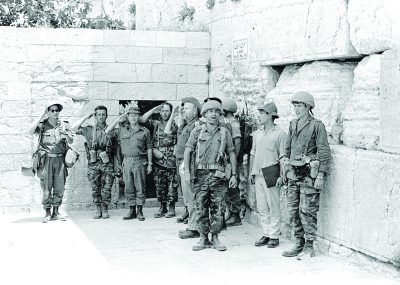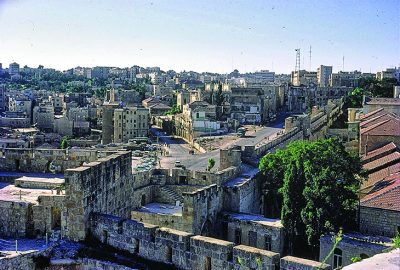×


We have detected your country as:
Please click here to go to the USA website or select another country from the dropdown list.
by: Ilse Strauss, News Bureau Chief
 Jerusalem today is an explorer’s paradise. You can watch the sun rise from the Mount of Olives before taking the pilgrims’ path down the slopes to Gethsemane, where Christian tradition says Jesus (Yeshua) prayed before His crucifixion. From there, you can slip through the Lion’s Gate to marvel at the Western Wall that has stood as the heart of Judaism for nearly 2,000 years—all before heading back to a bustling metropolis where high-speed trains and belching busses snake through streets lined with high rises and chic cafes.
Jerusalem today is an explorer’s paradise. You can watch the sun rise from the Mount of Olives before taking the pilgrims’ path down the slopes to Gethsemane, where Christian tradition says Jesus (Yeshua) prayed before His crucifixion. From there, you can slip through the Lion’s Gate to marvel at the Western Wall that has stood as the heart of Judaism for nearly 2,000 years—all before heading back to a bustling metropolis where high-speed trains and belching busses snake through streets lined with high rises and chic cafes.
It wasn’t always like that though. Fifty-six years ago, Jerusalem was a city divided. From 1948 to 1967, the City Line—a 4.3-mile (7-km.) stretch of barbed wire, concrete barriers, No Man’s Land and military posts—split the city into western Jerusalem under Israeli rule and eastern Jerusalem, including the Old City and the Western Wall, under Jordanian occupation. Hashemite snipers stationed along the barbed wire used Israeli citizens for target practice, landmines dotted No Man’s Land and the City Line lay like a jagged tear through the heart of the city, separating, segregating and restricting.
The State of Israel was a day old when the army of Jordan joined four other Arab countries to annihilate the reborn nation. Against all odds, Israel triumphed. Yet Jordan’s Arab Legion managed to overrun and occupy a patch of the Promised Land, annexing Jericho, Bethlehem, Hebron and finally, the eastern part of Jerusalem.
On November 30, 1948, Israeli and Jordanian commanders huddled over a map in an abandoned house in Jerusalem to draw the armistice lines of the ceasefire that would carve up the city. Once they were finished, the eastern part of the city—with the Old City, Western Wall, Mount of Olives and its ancient Jewish graves, Gethsemane and the Garden Tomb—fell under Hashemite rule.
The Red Cross immediately ushered the remaining 1,300 plus Jewish residents of the Old City out the Zion Gate. And for the first time since King David chose Jerusalem as the capital of Israel, the spot where God pledged His lingering presence perpetually (1 Chron. 7:16) was judenrein (a term of Nazi origin, indicating an area “cleansed” of Jews). The Hashemite forces proceeded to destroy the Jewish Quarter, decimating schools, synagogues and tombstones.
A year later, Jordan formally annexed the portion of the occupied Promised Land, including eastern Jerusalem, a move that only Iraq, Pakistan and the United Kingdom recognized.
The boundary lines scribbled in an abandoned home in a war-torn city became a barbed-wire border dividing that city between occupier to the east and rightful owner to the west for nearly two decades.
In 1950, Israel declared Jerusalem its capital. The government invested in education, infrastructure and housing. The city and her people flourished. Jordan retained Amman as its capital, reducing eastern Jerusalem to a squalid backwater with substandard education, infrastructure and housing. Yet instead of seeking an independent Palestinian state with east Jerusalem as its capital, the Arab residents of the now judenrein part of Jerusalem opted instead to swear fealty to the Hashemite king.
 Jerusalem is home to 30 holy places important in Judaism, Christianity and Islam. Three of these lie in the western part of the city. The remaining 27—including the Western Wall, the holiest spot in Judaism, the Dome of the Rock and Al-Aqsa Mosque, the third holiest spot in Islam, and the Church of the Holy Sepulchre—nestle in eastern Jerusalem.
Jerusalem is home to 30 holy places important in Judaism, Christianity and Islam. Three of these lie in the western part of the city. The remaining 27—including the Western Wall, the holiest spot in Judaism, the Dome of the Rock and Al-Aqsa Mosque, the third holiest spot in Islam, and the Church of the Holy Sepulchre—nestle in eastern Jerusalem.
The 1949 Armistice Agreements guaranteed Israelis access to the holy places now under Hashemite rule and called for a special committee to put the necessary plans in place. Yet for the next 19 years, neither Jewish nor Muslim Israelis were allowed to set foot in eastern Jerusalem.
And so it happened that for the first time since the destruction of the Second Temple made the Western Wall the holiest spot in Judaism, Jewish prayer and worship in the shadow of the ancient structure fell silent.
On the eve of the 1967 Six Day War, reunifying divided Jerusalem was not on Israel’s radar. The war to come was about survival, striking Egypt and Syria before they could attack first. Israel dispatched a message to the Hashemites, urging them to stay out of the fight. Yet roused by false reports from Cairo and Damascus boasting about a “glorious victory against the Zionists,” Jordan jumped into the fray. Less than 48 hours later, the Israeli flag unfurled over the Old City. Israeli Jerusalem tripled in size and Jordanian Jerusalem was no more. And for the first time since the city fell to the Romans in AD 70, it was wholly back in the hands of the descendants of King David.
The City Line, barbed wire and No Man’s Land disappeared. Religious groups were granted free access to the sites prominent to their faiths. Eastern Jerusalem was integrated and placed under the law, jurisdiction and administration of Israel. Overnight, Israel became responsible for an additional hundreds of thousands of people and assumed responsibility for their infrastructure and public services. Israel even offered them a path to Israeli citizenship, which few accepted.
 In the Eternal Council of God
In the Eternal Council of GodJerusalem stood as the capital of the Jewish people 1,000 years before it became sacred to Christianity and roughly 1,700 years before Islam staked its claim. Yet in the 56 years since Jerusalem was returned to its rightful owners, world bodies, international leaders and foreign governments have urged Israel to undo the reunification. Few countries recognize Israel’s jurisdiction over the western part of the city, let alone the eastern part, referring to Jerusalem as “occupied territory,” which Israel annexed illegally.
The fierce opposition to a Jewish Jerusalem shouldn’t surprise us. Scripture teaches that the piercing eyes of the world will continually be drawn to this city, with Jerusalem becoming a “cup of drunkenness” and a “very heavy stone for all peoples” (Zech. 12:2, 3).
Perhaps Bible teacher Derek Prince said it best, “In the eternal counsel of God, He has determined to make Jerusalem the decisive issue by which He will deal with the nations. Those nations who align themselves with God’s purposes for Jerusalem will receive His blessing. But those who follow a policy in opposition to God’s purposes will be severely dealt with.”
Photo Credit: Click on photo to see photo credit
Photo License: Old City
Photo License: Israeli Paratroopers
Photo License: Jerusalem in the 1960s
All logos and trademarks in this site are property of their respective owner. All other materials are property of Bridges for Peace. Copyright © 2024.
Website Site Design by J-Town Internet Services Ltd. - Based in Jerusalem and Serving the World.